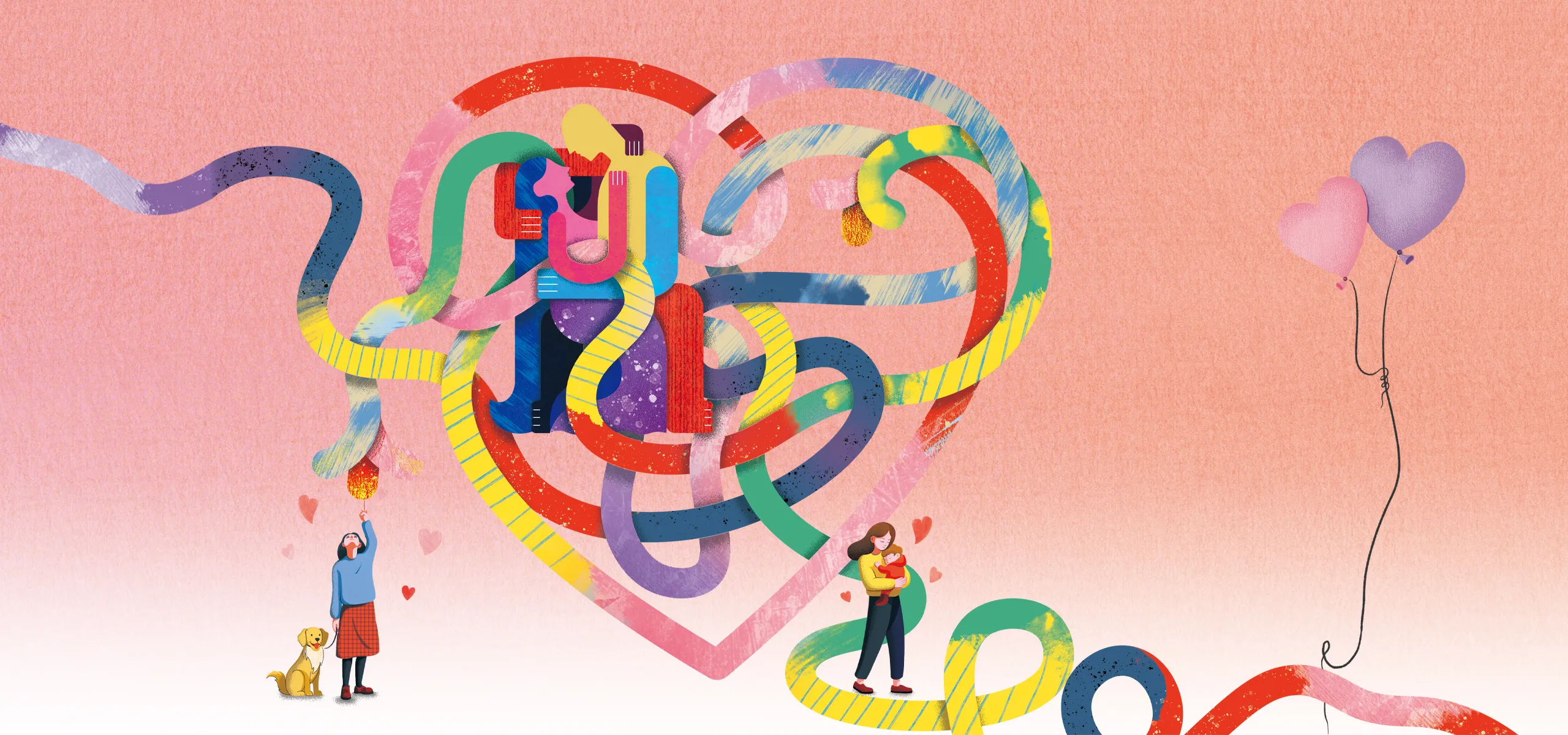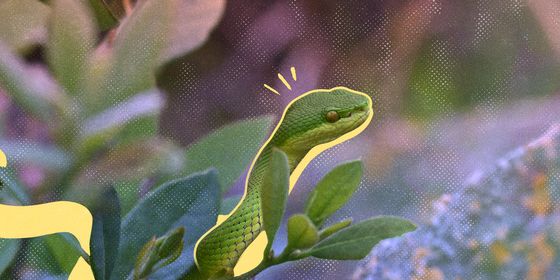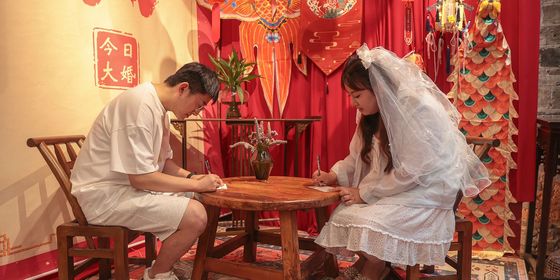Explore the character for romantic love, parental devotion, benevolence, and much more
It’s Valentine’s Day once again, a day for lovers, and for non-lovers to wish never existed. In Chinese, the holiday translates to 情人节 (Qíngrén Jié), and not as you might guess, 爱人节 (Àirén Jié), since 爱人 is exclusively used to refer to spouses. However, the character 爱 encompasses a world far larger than mere adoration and romance.
Love is often cautious, which might explain why the character once meant “to hide” or “conceal.” In the Classic of Poetry (《诗经》), China’s earliest collection of poetry dating back to the 11th century BCE, one verse depicts a vivid scene of a young man confounded by the coy elusiveness of his date: “She hides and I pace back and forth, scratching my head in distress (爱而不见,搔首踟蹰 Ài ér bú xiàn, sāoshǒu chíchú).”
More Reads for Valentine’s Day:
- Six stories of love and affection from Chinese history
- Charm your Valentine with these romantic lines from ancient Chinese poetry
- Fiction | How a mysterious accident weaves together the fate of two families
As with most Chinese characters, the written form of 爱 has evolved over time. But whether scratched on bamboo slips in the fifth century BCE, or later inscribed on paper in its traditional form 愛, it retained its components for “heart (心 xīn)” and “walking (夊 suī).” Around the sixth century, the cursive script popular at the time merged these two components into a new radical, 友 (yǒu), and giving rise to the simplified character 爱 that we are familiar with today.
Beyond romance and friendship, kinship, from 母爱 (mǔ’ài), “motherly love,” to 父爱 (fù’ài), “fatherly love,” is another source of this deep affection. The character can also mean “beloved” in phrases like 爱妻 (àiqī), “beloved wife,” or 爱女 (àinǚ), “beloved daughter.” Traditionally, people would also use 令爱 (lìng’ài), literally “your beloved one,” as a polite way to refer to other people’s daughters.
In ancient Chinese philosophy, 爱 is also a crucial quality of the ideal human, or 君子 (jūnzǐ). The fourth-century BCE scholar Mencius, a protégé of Confucius, stated that to be a moral person is to be benevolent. He famously said, “仁者爱人 (rénzhě ài rén),” meaning “Benevolent people love others,” and, “爱人者,人恒爱之 ( ài rén zhě, rén héng ài zhī),” which translates to, “He who loves others is constantly loved by them.” Benevolence (仁爱 rén’ài) was therefore a highly commended trait among some ancient rulers, with historians often describing them as “loving their subjects like their own children (爱民如子 ài mín rú zǐ).”
A different school of Chinese ancient philosophers called the Legalists, on the other hand, believed that showing too much benevolence was bad for running the country. One such adherent to this philosophy was scholar Han Fei (韩非), who could be described as China’s Machiavelli, stating in the third century BCE, “excessive affection leads to the failure of laws (爱多者则法不立 ài duō zhě zé fǎ bú lì).”
No matter which school of thought you subscribe to, you’re likely aware of love’s contagious quality—sometimes even extending to nearby animals. Like the English saying “Love me, love my dog,” the Chinese equivalent is “Love someone, love the crows on their roof (爱屋及乌 àiwū jíwū).” Encroaching wildlife or not, not all forms of affection should be encouraged. Take 宠爱 (chǒng’ài), “pamper,” and 溺爱 (nì’ài), “spoil,” for example—excessive indulgence can go to the recipient’s head.
Besides “love,” 爱 can also mean “to like” or “to enjoy,” exemplified by the idiom 爱不释手 (àibúshìshǒu), meaning “to enjoy something so much that one cannot let go of it.” There are also a variety of related verbs formed by 爱, such as “to take care of (爱护 àihù)” and “to cherish (爱惜 àixī).” To preserve one’s reputation, it is recommended to “be like a bird that cherishes its feathers (爱惜羽毛 àixī yǔmáo).”
The character 爱 can also function as a verb by itself, describing an action that occurs naturally or frequently, even if not favorably. For example, 他爱晕车 (Tā ài yùnchē), “he often gets car sick,” 她爱脸红 (Tā ài liǎnhóng), “she often blushes,” and 山里爱下雨 (Shān li ài xiàyǔ), “it always rains in the mountains.” Along similar lines, in the phrase 那两口子爱吵架 (Nà liǎngkǒuzi ài chǎojià), you should not mistake your friends as “that couple that loves to quarrel,” but as the ones who “always quarrel.”
And then there’s the downright negative. Coupled with 不 (bù, no, not) and used before certain verbs, 爱 can convey a sense of discontent. For instance, 爱搭不理 (àidā bùlǐ) means “to ignore someone deliberately,” while 爱来不来 (àilái bùlái) means “whether you come or not, it’s up to you,” with a distinct passive aggressive tone.
On a more romantic note, you may prefer to emulate the Western Han dynasty (206 BCE – 25 CE) diplomat Su Wu (苏武) this Valentine’s. On the eve of a diplomatic journey to visit the nomadic Xiongnu tribes in the northern regions, a trip bound to be fraught with danger, Su left a poem for his wife that opens with the verse, “From the moment we were married with our hair bound together, our love and affection have never wavered or been doubted 结发为夫妻,恩爱两不疑 (Jiéfà wéi fūqī, ēn’ài liǎng bù yí).” He goes on to say that he would strive to return, and even in death, would forever love her.
Last but not least, no matter how you decide to spend your Valentine’s, learning to love yourself may be the most important lesson of all. And sixth century BCE Daoist philosopher Laozi said it best when he instructed that we strive “To know oneself without seeking to be seen, to love oneself without elevating oneself above others (自知不自见,自爱不自贵 Zì zhī bú zì xiàn, zì ài bú zì guì).”
爱: The Character Defining Love in Its Many Forms is a story from our issue, “Youthful Nostalgia.” To read the entire issue, become a subscriber and receive the full magazine.













